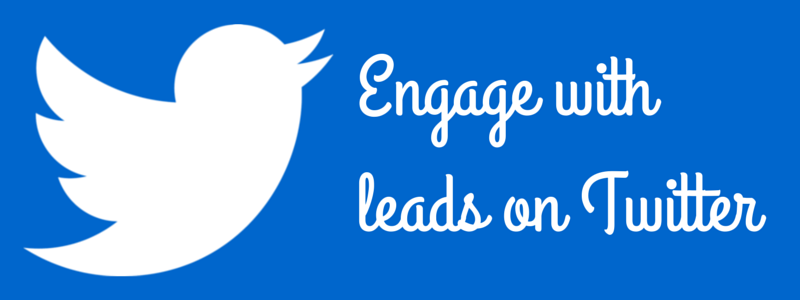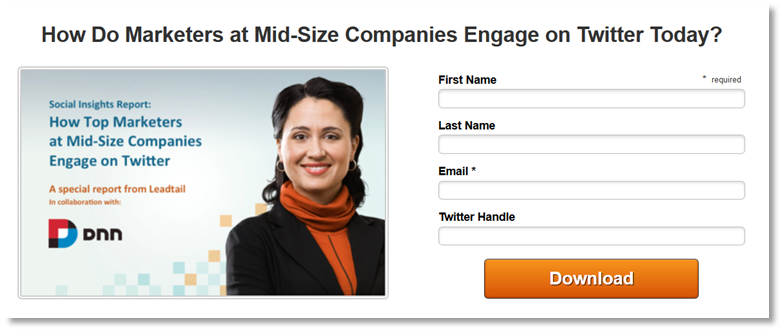
CONGRATULATIONS! You provide factory automation software
and the general manager of the world’s largest contract manufacturer just
downloaded your latest eBook. Time to ring the marketing gong, right?
WRONG. The general manager gave you her name, title,
company name and mailing address. But the email address she provided was
(dylansmom) at (yourdomain.com). So your nurturing emails will be able to
reach “Dylan’s Mom,” but
Sales is likely to look at the email address and move
on.
Granted, there are services that marketers can use to
augment contact record data (i.e. in order to obtain the work email of Dylan’s
Mom). This post highlights
another avenue to pursue.
Ask for their Twitter Handle

Pictured: This form at
Leadtail asks for Twitter Handle. Feel free to register for the report.
At a recent meeting of the
Direct Marketing Association of Northern California, Leadtail shared interesting findings about a
registration page that included “Twitter Handle” as a form field. Even with “Twitter
Handle” being an optional field, Leadtail reported that
70% of form completions included the user's Twitter
handle!
Of course, we’re talking about a report on how marketers engage on Twitter. So interested users are more likely to provide their Twitter handle. But still: 70% of users opted to provide an additional piece of
data. And my, what a valuable piece of data it is.
The rest of this post will detail seven reasons why
the Twitter handle is the new email address. Before we go further, however: make the Twitter handle an
optional field. While everyone has an email address, not everyone is on
Twitter.
1) The act of opting in makes it valuable
Why do people use their personal email addresses on lead capture forms?
First, because you made email address a required field (so they have to provide
something). And second, they find it easier to sort through all the
marketing-related “touches” in a
location that’s separate from their inbox at
work. Perhaps they’re just doing research and don’t want their work email to be
filled up with email promotions.
The Twitter handle helps supplement the other contact
details you’re collecting. If users opt to provide you their Twitter handle,
there’s a higher likelihood that the handle is both valid (the account exists)
and viable (they’re actively tweeting or at least logging in to their account).
2) A Twitter handle stays with you across jobs

Photo source: User mjtmail on
flickr.
Some Twitter users incorporate their company name within
their handle (turns out @DNNDennis is already taken!). When those users get a
new job, they’ll
change the handle, but keep the account. Let’s say the general
manager (Dylan’s mom) takes a new job. You notice that she’s opened and clicked
on a number of nurturing emails that you sent her. You decide to check her
Twitter profile and notice it's been updated with her new job and title. What a great time
for your sales rep to check in with her!
3) You can politely engage with sales prospects on Twitter
NeedTagger published a fantastic blog post, “10 Ways to Introduce Yourself to a Prospect on Twitter.” The beauty of Twitter is that everything
is public. Users who volunteer their Twitter handle to you
provide an implicit signal that you can engage with them (politely) on
Twitter. Just make sure you stick to NeedTagger’s suggestions, while
avoiding the “5 Ways to Make a Bad Impression” that they cover later in
the post.
 "Engaging on Twitter is the new lead nurturing."
"Engaging on Twitter is the new lead nurturing."
4) If they follow you back, you can DM them
You should follow every prospect who provided you with
their Twitter handle. Some may follow you back right away, while others might
wait until they’ve had meaningful interactions with you (see point number 3
above). When they do follow you back, you’re given the “privilege” of sending
them a Direct Message (DM) on Twitter.
Make sure you
treat this privilege
accordingly, as it can be taken away. If you behave badly, the user can report
you (as a spammer). Or even simpler, they may choose to unfollow you.
Side note: I know some Twitter users who respond quicker
to a Direct Message than an email to their work address.
5) You can see what they’re saying
Assuming users aren’t using protected accounts (i.e. to
see their tweets, you have to be approved by them), you can see everything the
prospect is tweeting about. It’s fascinating, really: you get to learn about
their hobbies, their interests, what they’re reading, what their kids are
eating and more. Occasionally, you’ll learn key facts that can help you advance
the sales cycle (e.g. learning about a pain point with a competitor’s
offering).
6) You can search the past

Pictured: Twitter's
advanced search capability. Did you know it provides sentiment analysis options?
As if the present wasn’t good enough, you can also search
the past! Twitter has basic and advanced search capabilities, which allow you
to see all the wonderful nuggets your prospects have tweeted about in the past.
Want to know why your prospect chose a competitor’s offering? A tweet from 18
months ago may hold the answer.
7) You can establish trust and build a relationship
It’s necessary to earn someone’s trust before they’ll buy
from you. The content you share on Twitter and the interactions you have with
users can go a long with to establishing and building trust. It's much harder to build the same amount of trust with nurturing emails.
3 Reasons It’s Not the Silver Bullet

Photo source: User dwstucke on
flickr.
After reading this,
don’t go out and scrap your marketing
automation system, as that would be a big mistake. Keep the following in mind:
1) It Requires lots of time, attention and TLC
Engaging on social media is an art, not a science. Some
do it well, some don’t. You’ll need to designate individuals on your team to
handle Twitter engagement. You may need to train them. Don’t try to automate
it.
2) It doesn’t scale well
Marketing automation scales well. As you go from 100 to
10,000 to 100,000 contacts in the system, you marketing automation system
handles that just fine. You incur additional costs (related to the growth in
contacts), but you don’t need to hire 5x or 10x the amount of staff to manage
it.
On the other hand, Twitter engagement requires a human
touch, so your staffing needs will scale linearly. As you expand the magnitude of your efforts, you may find that this linear scaling is not sustainable.
3) The data and measurement are less granular
With marketing automation, emails sent by the system include metrics on
delivery, open rate and click rate. When users click on emails, marketing automation can
trace users’ journeys through our websites. This data and measurement allows
marketers to allocate revenue back to the content assets that contributed to
the deal. This is much harder to track with Twitter engagement,
primarily because that data is not tied back to CRM (Customer Relationship
Management) systems.